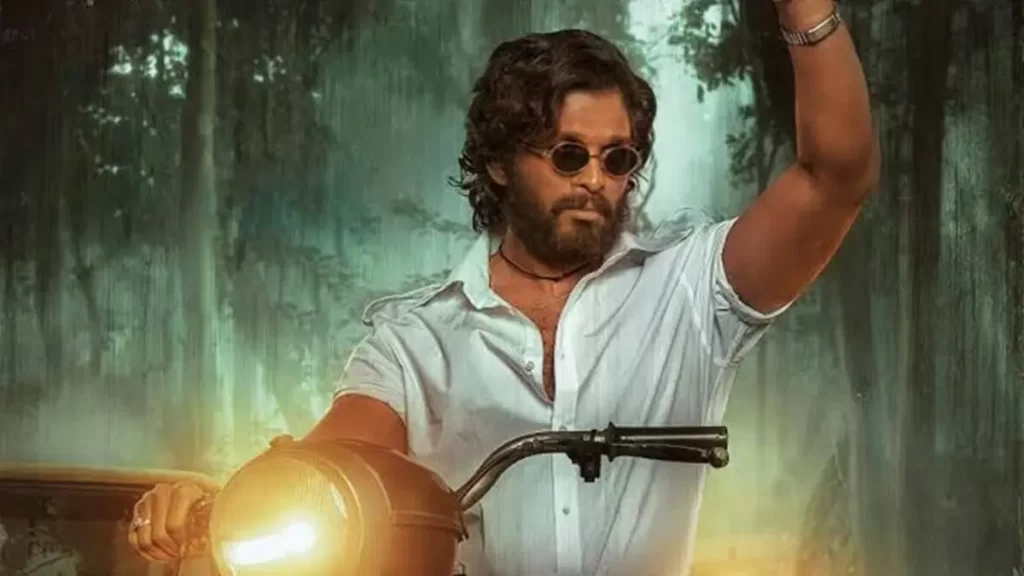Once the Fahadh character moves out to make way for a new set of villains, the film’s energy drops. The last hour appears interminable. The new villains are generic and unmemorable, and the film becomes all about Pushpa Pushpa Pushpa. The rest of this review may have spoilers, so read/watch at your own discretion.
The first installment of Pushpa, written and directed by Sukumar, was based on one external narrative and one internal narrative. The external journey of the protagonist, played by Allu Arjun in a National Award-winning performance, was a meticulously detailed account of how a “coolie” rose up the ranks of a red sandalwood-smuggling syndicate, making deals with various people from the criminal empire. The second journey, the internal journey, was about Pushpa being the bastard son of a local bigshot, and how he was constantly battling the angst that he did not have a legitimate “father’s name”. These two narratives came together spectacularly in the last half-hour, with the entrance of the psychotic cop played by Fahadh Faasil, named Bhanwar Singh Shekhawat. He became a part of both the external and the internal journeys, by setting out to end Pushpa’s criminal activities and also by questioning his identity.
Pushpa 2, called “The Rule”, is at its best when it stays on the cat-and-mouse game between Shekhawat and Pushpa. Pushpa humiliated Shekhawat at the end of the first film, and that humiliation becomes as much a source of angst for Shekhawat as Pushpa’s illegitimacy is to Pushpa. So, in a way, Shekhawat, too, gets an external and internal journey: namely, to put an end to Pushpa’s reign of crime, and to somehow salvage his ego after the humiliation. From the opening scene, the film keeps switching back and forth between the external and the internal. The terrific hero-introduction shot occurs in Japan, when a container of red sandalwood is seized – and just as we think we are getting a full-on, “heroic” action scene, we cut abruptly to Pushpa’s vulnerable childhood, where boys make fun of his parentage. And then on, like in Part 1, we get one solid mass scene after another.

When it comes to the macho “masala” film and its rowdy cousin, the “mass” film, Telugu cinema still does it best, especially with actors who go out on a limb like Allu Arjun and Fahadh Faasil. Let me list a few scenes that are fascinatingly (and sometimes nuttily) out of the box: the one that involves policemen standing in line, the bit in a song where Pushpa lights a cigarette from his shirt that has accidentally caught fire, the series of events that lead to a photograph with the Chief Minister, the negotiations with a crook in the Maldives, the entire stretch about Pushpa apologising to Shekhawat, the chase that involves a dam and elephants and cattle, the conversation that occurs entirely through whistling… Sure, some of this could have been shorter in a film that goes on for nearly three-and-a-half hours. But then, perhaps shortness is not something you should expect in a movie where everything is big.
Pushpa’s house is big. The film’s scale (each frame) is big. In an amusing running gag, Srivalli’s (a very effective Rashmika Mandanna) sexual appetite is big. Pushpa’s dress sense – the gold buckle, the painted nail, the printed shirts – is big. Devi Sri Prasad’s music is big. The erotically charged choreography is big. The colours are big. The crowds are big. The action scenes, especially a chase in the sea, are big. And the temple festival sequence is one of the biggest stretches of writing, with varied emotions, I have ever seen. It begins with a sentimental moment involving Srivalli. It moves on to Pushpa’s reaction to this revelation, which is presented in dance form. And then we get the introduction of new villains, who will take the story forward. This results in an action sequence. And after sentiment, dance, character establishment, and action, we get a long dramatic sequence that circles back to Pushpa’s illegitimacy, with Srivalli standing up for her husband. One of the most interesting aspects of Pushpa 2, the film, and Pushpa, the character, is how vulnerable and emotional the man is, despite the macho things he does in his trade. Allu Arjun plays both the internal and external aspects of Pushpa in a perfectly larger-than-life metre, and Fahadh Faasil is super-entertaining as a volatile cop who doesn’t seem to know, himself, what he will do next.
But once Shekhawat moves out to make way for the new set of villains, the film’s energy and inventiveness drop drastically. I wanted more of the cat-and-mouse game between Shekhawat and Pushpa. While it’s understandable that we need the new villains to bring about closure to Pushpa’s illegitimacy issue, these portions go on and on. The last hour appears interminable. The new villains are generic and unmemorable, and the film becomes all about Pushpa Pushpa Pushpa. The emotion that was palatable in bits and pieces, in between the external journey, now becomes the sole driving factor of the film. And the story becomes predictable and a drag. Important characters like the ones played by Sunil and Anasuya disappear, and we keep staring at the same set of faces. Pushpa: The Rule works up to a point, until it turns into a stereotypical action-sentiment spectacle, with the threat of rape still being used to goad the hero into action. The film ends with a set-up for Part 3. It’s definitely of interest. But I hope they stick to what worked in Part 1 and the Shekhawat parts of this film. Pushpa is at his best when outwitting people who are trying to bring him down. Otherwise, he is just another action hero doing fan service.


